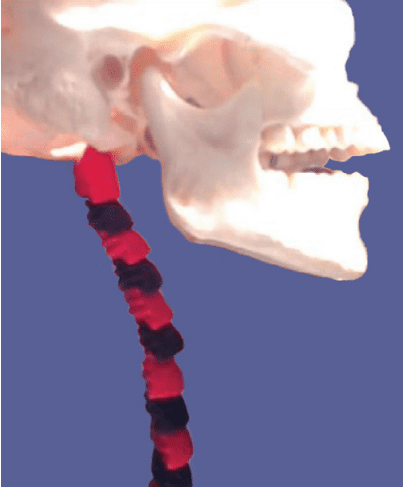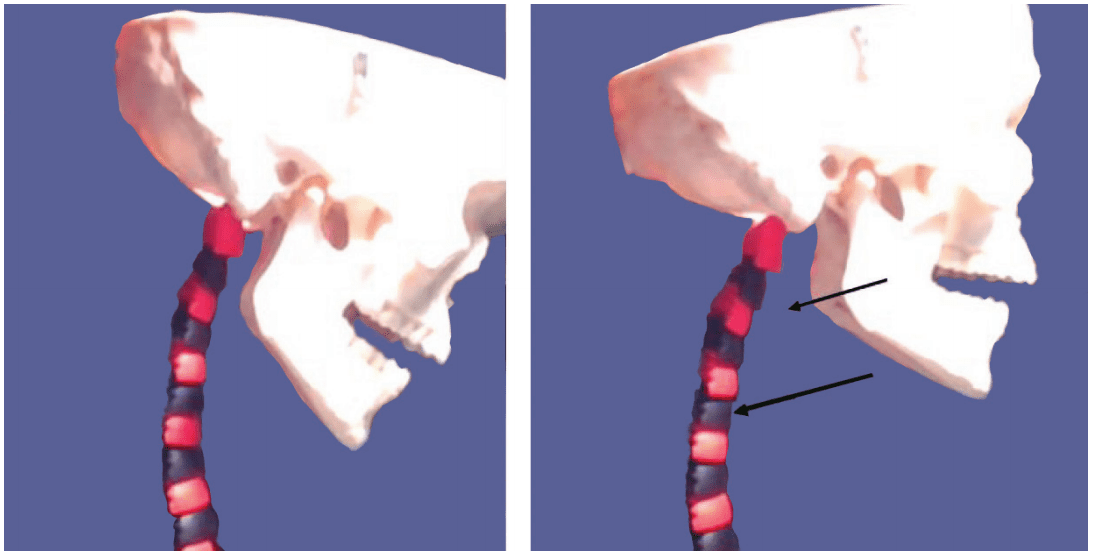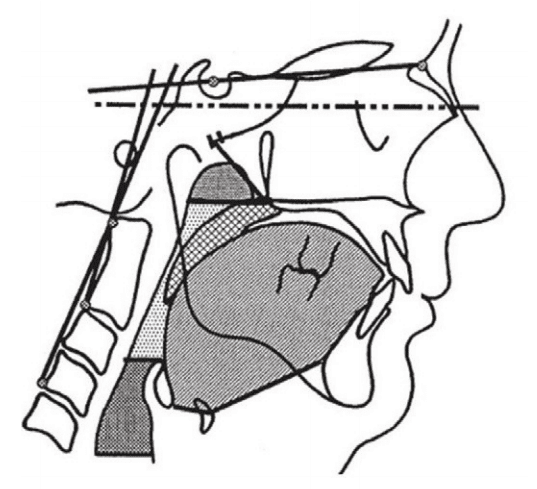Published December 16, 2020 in Dental Sleep Practice
Co-authored by Theodore R Belfor, DDS, and Michal Niedzielski, PT, PRC
Much attention has been given to blue light’s deleterious effects on sleep. Screen time’s negative impact isn’t limited to blue light though. Today’s over-reliance on cell phones, tablets, and computers contributes to a forward head posture which can affect breathing. Additionally, forward head posture should be viewed as an occupational hazard for dentists while treating patients.
What is FHP?
Forward head posture (FHP) is defined as forward translation of the cervical vertebrae and hyperextension of the upper cervical vertebrae. Cervical straightening is when there are changes from lordosis, a correct curvature in a cervical spine, towards kyphosis (a reverse curvature). (See Fig. 1 and Fig. 2)


However, there is a broader problem – inefficient respiration as a result of FHP. Dentists bring their heads forward and down to work with patients, similar to the posture many people exhibit when looking at a computer or cell phone screen. In a habitual FHP, the chin ultimately rises to bring vision to the horizon. When we bring the chin parallel to the ground, this causes a posterior cranial rotation, resulting in upper vertebrae hyperextension, midcervical flexion, and lower cervical extension. Looking down and focusing on small objects such as teeth, the eyes may begin to strain. Continuous over-convergence of the eyes may strain the extraocular and ciliary musculature tensing the eyes’ lenses so that small objects are in focus. This prolonged, slouched position increases back, neck, head, and eye tension as well as affecting respiration and digestion.1,2
The shape of the thorax is significantly changed by FHP. It causes expansion of the upper thorax and contraction of the lower thorax. Therefore, impairment to respiratory function can be explained by the restriction of the thoracic motion during respiration caused by this characteristic thoracic shape resulting from FHP.3 Because of this pattern, many of us will change the direction of airflow, from vertical, which is widening the lower chest to diagonal resulting in overuse of the neck and shoulder complexes and masticatory musculature. This also causes stomach distention and lower back compression. Breath holding is commonly observed with this pattern and recently the term “email apnea” was coined by former Apple executive Linda Stone.4
Pay Close Attention to Your Breathing When Examining or Treating Patients
FHP stretches the tongue which slides into the airway and compromises breathing. Evolving a smaller maxilla, modern humans have less room for the tongue on the roof of the mouth and the tongue has nowhere to go but down the throat. This obstructs and pressurizes the airway which facilitates even more FHP in order to improve volume and velocity of passing air.
Proper breathing is done by using your abdominal muscles. Dentists should be aware that the forward head posture and body position they assume while treating patients makes it difficult to breathe correctly because abdominal muscles are lengthened. As a result, the upper chest and neck muscles are tasked to assist in breathing. These morphological changes can result in improper breathing, predominantly with the upper chest and not the abdomen. This can overly tax muscles such as the scalene, sternocleidomastoid, and upper trapezius and may result in neck pain and headaches. FHP causes expansion of the upper anterior thorax and contraction of the lower posterior thorax, and these changes cause decreased respiratory function, as well as sympathetic dominance.5 This not only causes us to expend more energy than we need to, but it also tightens up compensatory muscles, and still provides a smaller volume of air than does expansion of lower posterior thorax during breathing.
Why is the quality and volume compromised? Because many of our lung’s alveoli lie in the lower posterior portions of the lungs. FHP is one of the greatest contributing factors to neck pain and causes a muscle imbalance.6 Muscle imbalance can be described as the respective inequality between the antagonist and agonist. Equilibrium is necessary for normal muscle movement. Imbalance will manifest in one group being overactive or too tight and the other underactive or too loose. As the head moves forward, musculature that attaches from the upper cervical and occipital region and inserts into the shoulder girdle, namely the upper trapezius and the sternocleidomastoid (SCM), will be in a shortened length-tension relationship. In contrast to their antagonists, the supra/infrahyoid group which will be in a lengthened length-tension relationship. Head forward posture relaxes the supra/infra hyoid complex and the genioglossus and hyoglossus. Over-recruitment of the upper trapezius will be a new norm. To maintain vision and a vestibular system parallel to the horizon, a strong reflexive alliance with the anterior temporalis, masseter, and pterygoid musculature is formed. Here is where we can lose pharyngeal airway tone. The suprahyoid/infrahyoid muscles maintain the tone of the pharyngeal airway. This is bad news for cell phone users, gamers, avid readers, and dentists.
Dentists should be aware that these cervical-masticatory issues can result in improper breathing and are related to obstructive sleep apnea (OSA). A typical severe OSA male patient portrays some cephalometric characteristics observed in Cranial Cervical Extension and FHP (Fig. 3).

There is a Class ll mandible which brings the tongue into the airway. The tongue then lifts the soft palate to obstruct the oropharynx. When the tongue is in the airway the head comes forward to allow for better breathing. The upper trapezius and the SCM muscles tighten to support the head and their antagonist muscles, the suprahyoid muscles, relax. This results in a low hyoid bone position, a biomarker for sleep apnea.
Theodore R. Belfor, DDS, is a graduate of New York University College of Dentistry, a Senior Certified Instructor for the International Association for Orthodontics (IAO) and has been in private practice for more than 40 years. Since 2001, Dr. Belfor has specialized in patient treatment with the Homeoblock™ orthopedic/orthodontic appliance designed with the Unilateral Bite Block technology®, for face and airway development in adults. Dr. Belfor has been lecturing, teaching and training dentists with the Homeoblock™ and his unique diagnostic protocol for more than 18 years worldwide. His work is devoted to understanding the causes of sleep and breathing disorders through individual patient craniofacial analysis. Dr. Belfor has been published in numerous journals. He can be reached through his site at drtheodorebelfor.com.
Michal Niedzielski, PT, PRC, graduated with a Master’s Degree in Physical Therapy from the Academy of Physical Education in Warsaw, Poland in 1992. Prior to starting the Comprehensive Physical Therapy (former Physical Therapy Center of Horseheads) in 1996 with Joyce Wasserman, Michal worked as a physical therapist for the Arnot Ogden Medical Center. In 2007, Michal earned the designation of being Postural Restoration Certified (PRC). He then returned to Poland to introduce the concepts of Postural Restoration to hundreds of students and physiotherapists. He lectured and taught courses in Poland at several universities. Michal currently sees patients whose conditions range from slight compensations with minor aches to a serious pathology with incapacitating pain. He can be reached through his site at comphysicaltherapy.us.
- Colombo, S Joy, M., Mason, L, Peper, E, Harvey, R, & Booiman, A (2017). “Posture Change Feedback Training and its Effect on Health. “Poster presented at the 48th Annual Meeting of the Association for Applied Psychophysiology and Biofeedback, Chicago, IL March, 2017. Abstract published in Applied Psychophysiology and Biofeedback, 42(2), 147.
- Devi, R R, Lakshmi, VV, & Devi, MG (2018). “Prevalence of discomfort and visual strain due to use of the laptops among college going students in Hyderabad. “Journal of Scientific Research & Reports, 20(4), 1-5.
- Koseki T, Kakizaki F, Hyashi S, Nishida N, Itoh M. Effect of forward head posture on thoracic shape and respiratory function. J Phys Ther Sci. 2019 Jan;31(1):63-68. doi:
- Stone L, Just breathe: Building the case for email apnea Huffington Post Feb. 2008
- Koseki T, Kakizaki F, Hyashi S, Nishida N, Itoh M. Effect of forward head posture on thoracic shape and respiratory function. J. Phys Ther Sci 28: 128-131, 2016
- Dae-Hyun Kim,a Chang-Ju Kim,b,* and Sung-Min Son Neck Pain in Adults with Forward Head Posture: Effects of Craniovertebral Angle and Cervical Range of Motion Osong Public Health Res Perspect. 2018 Dec; 9(6)

